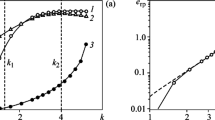Abstract
The Neuber-Novozhilov approach is used to obtain necessary and sufficient fracture criteria. Using a modified Leonov-Panasyuk-Dugdale model, simple relations for the critical fracture parameters are derived for opening mode edge cracks for the case where the diameter of the prefracture zone coincides with the diameter of the plasticity zone. These relations are suitable for studying fracture where the crack length is negligibly small. A fracture diagram using critical stresses under both criteria is proposed for a wide range of crack length. At a certain level of loading, three regions are identified, in the first of which the crack is stable, in the second, the crack extends but remains stable, and in the third, the crack is unstable. Experimental data on the fracture of specimens with edge cracks are obtained. It is established that the theoretical critical fracture curves are in good agreement with the obtained critical parameters for flat tensile specimens with two collinear edge cracks.
Similar content being viewed by others
References
V. M. Kornev, “Estimation diagram of quasi-brittle fracture for bodies with a hierarchy of structures. Multiscale necessary and sufficient fracture criteria,” Fiz. Mezomekh., 13, No. 1, 47–59 (2010).
G. Neuber, Kerbspannunglehre: Grunglagen fur Genaue Spannungsrechnung, Springer-Verlag, Berlin (1937).
V. V. Novozhilov, “On the necessary and sufficient criteria of brittle strength,” Prikl. Mat. Mekh., 33, No. 2, 212–222 (1969).
V. M. Kornev, “Generalized sufficient strength criteriia. Description of the prefracture zone,” J. Appl. Mech. Tech. Phys., 43, No. 5, 763–769 (2002).
V. M. Kornev, “Stress distribution and crack opening in the prefracture region (Neuber-Novozhilov approach),” Fiz. Mezomekh., 7, No. 3, 53–62 (2004).
M. Ya. Leonov and V. V. Panasyuk, “Development of fine cracks in a solid,” Prikl. Mekh., 5, No. 4, 391–401 (1959).
D. S. Dugdale, “Yielding of steel sheets containing slits,” J. Mech. Phys. Solids, 8, 100–104 (1960).
I. M. Kershtein, V. D. Klyushnikov, E. V. Lomakin, and S. A. Shesterikov, Fundamentals of Experimental Fracture Mechanics [in Russian], Izd. Mosk. Gos. Univ., Moscow (1989).
D. Broek, Elementary Engineering Fracture Mechanics, Martinus Nijhoff, Boston (1982).
A. Neimitz, “Jump-like crack growth models of theory of critical distances. Are they correct?” ESIS Newsletter, No. 44, 20–26 (2008).
M. P. Savruk, “Stress intensity factors in bodies with cracks,” in: Fracture Mechanics and Strength of Materials [in Russian], Vol. 2, Naukova Dumka, Kiev (1988), p. 620.
Y. Murakami (ed.), Stress Intensity Factors Handbook, Vol. I, Pergamon Press, Oxford-New York (1987).
D. Taylor, “The theory of critical distances,” Eng. Fract. Mech., 75, 1696–1705 (2008).
A. G. Demeshkin and V. M. Kornev, “Crack path kinking under generalized stress state,” J. Appl. Mech. Tech. Phys., 50, No. 3, 532–539 (2009).
T. V. Krasnikova and E. B. Petrilenkova, Foams Based on Polymer Binders and Microspheres [in Russian], Leningr. Dom Nauch.-Tekh. Propagandy, Leningrad (1971).
P. G. Krzhechkovskii, “Fracture mechanics of spheroplasts,” Probl. Prochnosti, No. 11, 110–115 (1982).
E. V. Karpov, “Fracture of spheroplast samples with different types of stress concentrators,” J. Appl. Mech. Tech. Phys., 43, No. 4, 630–637 (2002).
B. D. Annin, A. G. Demeshkin, and E. V. Karpov, “Various mechanisms of fracture of spheroplasts,” in: Tr. Tsentr. Nauch.-Issled. Inst. Krylova, No. 52, 13–20 (2010).
F. Berto and P. Lazzarin, “On higher order terms in the crack tip stress field,” Int. J. Fract., 161, 221–226 (2010).
A. Cornec, I. Scheider, and K.-H. Schwalbe, “On the practical application of the cohesive model,” Eng. Fract. Mech., 70, 1963–1987 (2003).
G. Lin, X.-G. Meng, A. Cornec, and K.-H. Schwalbe, “The effect of strength mis-match on mechanical performance of weld joints,” Int. J. Fract., 96, 37–54 (1999).
V. M. Kornev and N. S. Astapov, “Model of fracture of a piecewise homogeneous medium during layering of elastoplastic structured materials,” Mekh. Komposits. Mater. Konstr., 16, No. 3, 347–360 (2010).
Author information
Authors and Affiliations
Corresponding author
Additional information
__________
Translated from Prikladnaya Mekhanika i Tekhnicheskaya Fizika, Vol. 52, No. 6, pp. 152–164, November–December, 2011.
Rights and permissions
About this article
Cite this article
Kornev, V.M., Demeshkin, A.G. Quasi-brittle fracture diagram of structured bodies in the presence of edge cracks. J Appl Mech Tech Phy 52, 975–985 (2011). https://doi.org/10.1134/S0021894411060162
Received:
Revised:
Published:
Issue Date:
DOI: https://doi.org/10.1134/S0021894411060162




